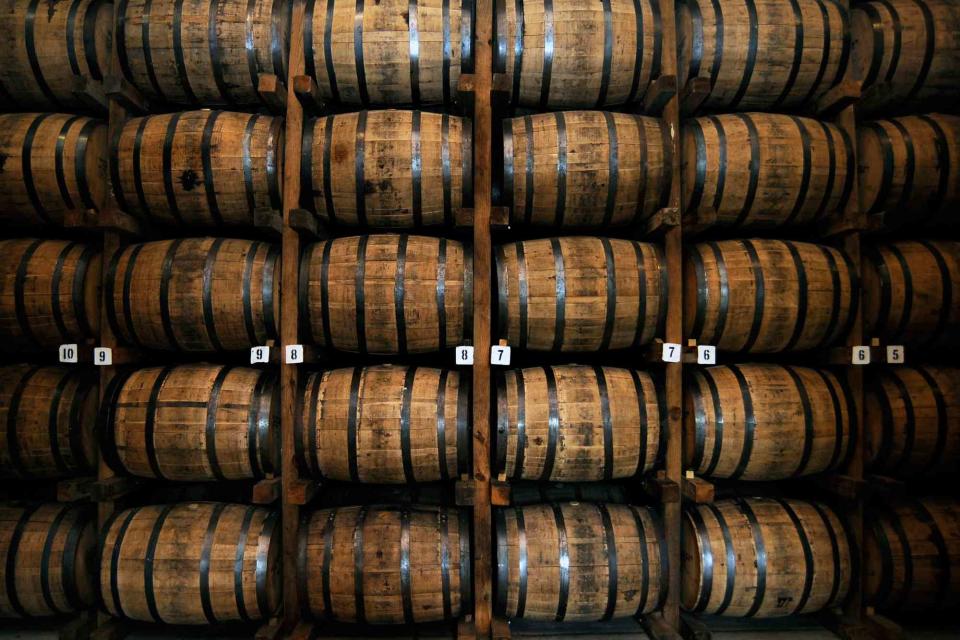What's the Difference Between Whiskey and Whisky?
No, it doesn't make sense when you say you love bourbon but hate whiskey.

Ben Pruchnie / Alamy Stock Photo
We’ve all heard it before, whether on television or in the movies, at the bar, or among family members. It goes something like this: “I like bourbon, but I really don’t like whisk(e)y all that much.”
It’s time to stop the madness!
In an effort to clarify once and for all why that sentence makes no sense at all, and to lay out in no uncertain terms what exactly constitutes whisk(e)y — and why we’re employing that fairly awkward parenthesis within the word itself — here is a taxonomy of whisky and whiskey, what connects and differentiates them, and how to refer to them properly.
Whisk(e)y is a spirit that’s produced from a distilled mash of fermented grains and then aged in wood. It represents the entire category — an umbrella of sorts — under which reside specific types of whisk(e)y: Scotch, Bourbon, Irish whiskey, Japanese whisky, and more.
Single malt Scotch whisky is spelled without an ‘e,’ must be produced in Scotland, and is based entirely on malted barley. Yet even within the category of single malt, there are massive differences: From Old Pulteney in the north to Lagavulin on Islay is nearly 300 miles, and there is a vast range of terrain in between. Of course single malt Scotch whisky is diverse!
:
I can’t count the number of times that I’ve heard some version of the refrain that so-and-so doesn’t like single malt Scotch because “it’s too smoky.” This is painting the category of single malt Scotch with too broad of a brush. The whiskies of Islay, for example, tend to be smoky since the malted barley is generally dried using peat-fueled fires. Conversely, the whiskies of the Highlands tend to boast lovely dried fruit and caramel notes. Yet there are exceptions: Bruichladdich’s Classic Laddie expression, for example, is unpeated even though it’s from Islay, and Glenmorangie’s new “A Tale of the Forest” is totally unique within the Highlands in that it’s made, as the label says, with “barley kilned with woodland botanicals.”
Single malt Scotch, in other words, runs the gamut in terms of style, despite its reliance on barley and no other cereal grains.
Other countries use the whisky spelling, too. Japan, India, and Australia are most notable. Traditionally, producers in Ireland and the United States use the “whiskey” spelling, but that’s confusingly not universal. Maker’s Mark omits the “e” on their labels, as does George Dickel, in Tennessee. Uncle Nearest is also made in Tennessee but utilizes the “whiskey” spelling. In general, however, “whiskey” is far more common in the United States across all categories and subcategories of the spirit.
Among American whiskeys (note the difference in spelling the plural version of whiskey versus whisky), Bourbon is arguably the most prominent. The category is defined as a spirit distilled from a fermented mash of cereal grains composed of at least 51% corn and aged in charred new barrels. In general, the vast majority of Bourbon aging occurs in American white oak, but the law just dictates charred new oak, not what specific kind. Finishing a Bourbon (and other whisk(e)y as well) in a separate barrel has become increasingly popular in recent years; Angel’s Envy led the way, and now many other brands have run with the practice.
As a side note, beyond that 51% minimum corn requirement in the mash bill, the other 49% can be composed of everything from more corn to rye, wheat, barley, and more; the key is that corn is the majority.
:
The other categories of legally defined American whiskey include rye whiskey (a minimum of 51% rye in the mash bill, which is essentially the list of grains used in the production of what’s called distillers beer, the slurry that’s ultimately fermented and then distilled into a spirit); corn whiskey, American single malt whiskey, wheat whiskey, rye malt whiskey, and malt whiskey.
Tennessee whiskey is an interesting category, as it’s essentially produced under the same regulations as Bourbon but with the added step of undergoing the Lincoln County Process, which is filtration through charcoal. Different brands have their own specific riffs on this process, but the charcoal filtering itself is what’s legally required for Tennessee whiskey, in addition to its production in the state. Interestingly, Bourbon is not required to be produced in Kentucky, though the vast majority of it is. Still, excellent ones are crafted from Oregon and Texas to New York, Pennsylvania, and beyond.
The point is this: Whiskey and whisky are very different spirits, with countless subsets in each. Yet whisk(e)y as an umbrella category does have many key aspects that tie them all together. Taste them, explore their differences and occasional similarities, and enjoy. Just don’t ever say you like Bourbon but don’t enjoy whisk(e)y. That makes no sense … which is only acceptable if you’ve had a few drams already.

